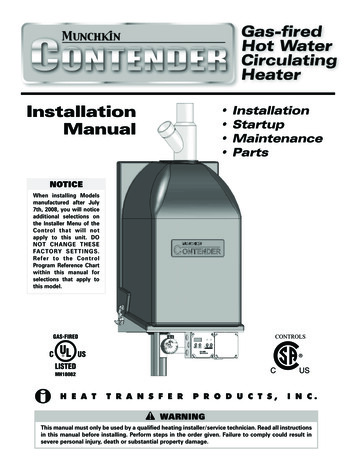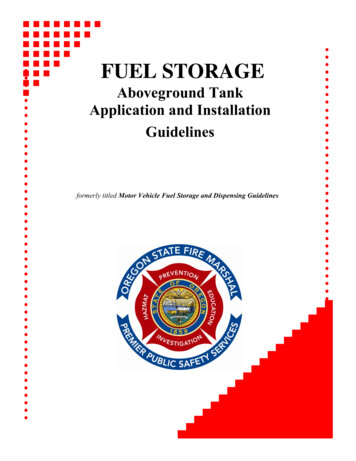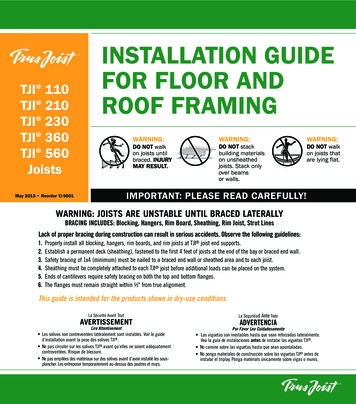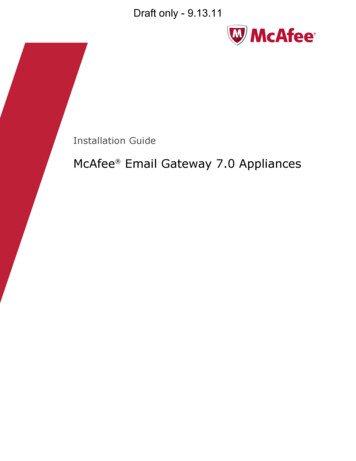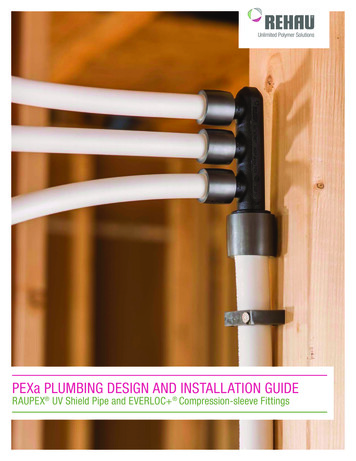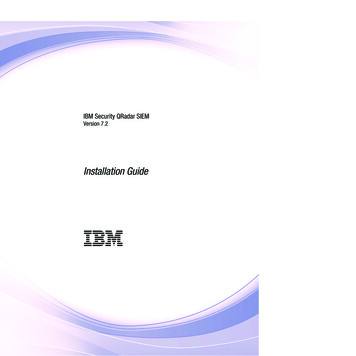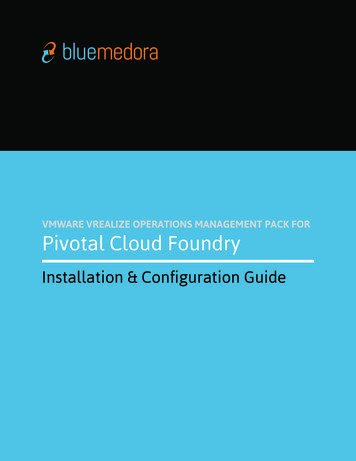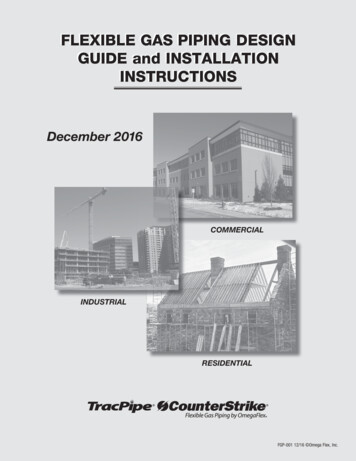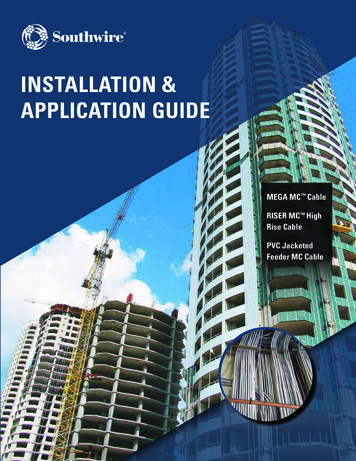
Transcription
INSTALLATION &APPLICATION GUIDEMEGA MC CableRISER MC HighRise CablePVC JacketedFeeder MC Cable1
PURPOSE OF THIS GUIDEThis guide provides engineers and contractors with essential information on the basic applications, selection,and installation of MC feeder cables including MEGA MC cable, Riser MC High Rise cable, and PVC JacketedFeeder MC cable. Southwire can provide additional support and/or consulting services for specific applications.Electrical contractors have used smaller MC cables for branch circuits for many years. The industry is nowusing more large MC feeder cable. These large cables offer the owners and contractor the same advantages asfound with the smaller MC cable branch circuits, and are now being used in most types of commercial construction,including apartments, condominiums, hotels, stadiums and office buildings.MC feeder cables provide a neat and orderly appearance, alternative to pipe and wire. This guide should addressmost concerns about handling and installing these large MC feeder cables.12
MC CABLE ADVANTAGEUsing Type MC cable, contractors can install multiple conductors with professional-looking, owner-satisfyingappearance in less time than it takes to hang empty conduit.Feeder MC cables can include up to five conductors plus a ground wire in wire sizes up to 1000 kcmil in a tough,flexible aluminum armor. MC cable puts an entire 600 volt feeder circuit into a single, rapid-installation assemblythat is NEC compliant for high-rise buildings, assembly halls, and many hazardous locations.REDUCED INSTALLATION STEPSThe biggest advantage of MC cable over pipe-and-wire installations is the reduction in overall time and labor toachieve neat, workman-like appearance, code compliance and owner satisfaction. A typical MC cable installationrequires only 5 steps, where comparable conduit applications require 14. MC cable reduces overall installed costsby roughly 30-50% when compared to pipe-and-wire systems.UNLIMITED 90-DEGREE BENDSPipe and wire installations require a pull box or junction box after every fourth 90 bend (total of 360degrees of bends). MC cables aren’t limited by that restriction. MC cable eliminates the need for junction boxesbetween pull points, and also the need for large pipe benders on the job.FACTORY TESTED ASSEMBLIESWith conduit installations, the vast majority of insulation damage happens during installation. MC cableassemblies are factory tested before leaving the plant, and conductors are fully protected inside the armorduring shipping and installation. That greatly reduces the potential for damaged conductors in the finished job.IDEAL FOR VERTICAL INSTALLATIONSSouthwire’s patented Riser MC High Rise cable is specifically designed for use in vertical installations withoutthe need for additional conductor supports, offsets, or junction boxes that would otherwise be required per NEC 330.30 and 300.19. This UL Listed, NEC compliant construction includes a polymeric binder jacket over theconductors and under the armor that provides continuous support of the conductors throughout the entire length ofthe cable. Riser MC High Rise cable is UL Listed and NEC recognized as Type MC cable.COMPARISON OF COMMON INSTALLATION ITEMS, MC CABLE VS. CONDUITMCCONDUITYESYES6 Feet10 FeetSupport with clamps and trapezeYESYESAssembly testedYESNOUnlimited number of bendsYES360 MaximumRequires “neat and workmanlike” installationRequired supports(maximum length between supports)Note: Beginning with the 2014 National Electrical Code (NEC), article 330.30(B) allows for listed MC Cables(including Riser MCTM High Rise Cable) with ungrounded conductors 250kcmil and larger to be secured at intervalsnot exceeding 10 feet in vertical installations. Prior to the 2014 NEC, this securing requirement was every 6 feet.32
TABLE OF CONTENTSSECTION 1. PRE-ORDER, PRE-INSTALLATION CHECK LISTDETERMINING CONDUCTOR TYPES. 6Copper conductors.68000 Series aluminum alloy conductors.7NUMBER OF CONDUCTORS IN ASSEMBLY, AND CABLE LENGTH.7PARALLEL CIRCUITS.7REFERENCE INFORMATION.8NEC Table 250.122 Minimum Size Equipment Grounding Conductorsfor Grounding Raceway and Equipment.8CABLES FOR DIRECT BURIAL OR CONCRETE ENCASED.8CABLES FOR VERTICAL RUNS.8MC CABLE FITTINGS.8MAXIMUM REEL SIZES.9CABLE SUPPORT SYSTEM.9ROLLERS AND SHEAVES NEEDED FOR INSTALLATION.9SECTION 2. CABLE RIGGING AND INSTALLATIONHANGING THE SUPPORT SYSTEMS.10Support intervals.10Supporting MC cable in vertical applications.10Channel struts and threaded rod.11Straps and cable clamps.11Basket type wire mesh.12INSTALLING ROLLERS AND SHEAVES.12Pulley sizes and count.13Sheave wheel sizes and types.13Roller spacing and mounting.13PREPARING MC CABLE FOR INSTALLATION.14Cutting and stripping MC cables.14PULLING MC CABLE.15Assessing the pull.15General caution about bending radius and sidewall pressure.15Bending radius for permanent training.15Bending radius for cable under tension.16Securing pull rope.1734
TERMINATING MC CABLES.18Cable fittings.18Transitions and splicing.18Hardware manufacturers.19REFERENCE INFORMATION.19Support in Vertical Raceways.19NEC 330.24 Bending Radius.19NEC 330.30 Securing and Supporting.19SECTION 3. APPLICATION AND DESIGN GUIDESPECIFYING “NEAT AND WORKMANLIKE” INSTALLATIONS.20ADDITIONAL APPLICATIONS OF MC CABLE.20Wet locations.20Direct burials.20Concrete encased.20Vertical Installations.20DESIGN OPTIONS FOR FUTURE ELECTRICAL NEEDS.21GROUNDING CONSIDERATIONS.21Equipment grounding conductors for cables in parallel circuits.21MC CABLE REPAIR.22NEC COMPLIANCE.22NEC Uses Permitted.22NEC Uses Not Permitted.22NEC References for Type MC cable.23UL COMPLIANCE.25UL standards and directories.25UL general information for electrical equipment. 25UL product markings.26UL listing information.26MC feeders and fire-rated assemblies.27REFERENCE INFORMATION.28NEC 330.10 Uses Permitted.28NEC 330.12 Uses Not Permitted.28NEC 310.15 Allowable Ampacities of Insulated Conductors Rated 0-2000 Volts.2954
SECTION 4. ANNEXESANNEX A. CALCULATING ROLLER SPACING AND CABLE PULLING TENSION.31Roller spacing calculations .31Pulling tension calculations .31Maximum tension on conductors.32Pulling tension calculations.32Multiple conductors.33Horizontal straight sections.33Inclined straight section.33Vertical sections.33Tension in bends .33Tension entering cable pull.34Feeding off reel horizontally .34Feeding off reel vertically .34ANNEX B. CABLE SPECIFICATIONType MC Feeder Cable .35Part 1 - General.35Part 2 - Product.36Part 3 - Installation.37ANNEX C. PRODUCT DATA SHEETSArmorlite MC Cable with Alumaflex Brand Triple E THHN/THWN-2 Conductors.38Armorlite PVC Jacketed Feeder MC Cable with Alumaflex Brand Triple E THHN/THWN-2 Conductors.42Armorlite Riser MC Cable with Alumaflex Brand Triple E THHN/THWN-2 Conductors.46Armorlite MC Cable with Alumaflex Brand Triple E XHHW-2 Conductors.48Armorlite PVC Jacketed MC Cable with Alumaflex Brand Triple E XHHW-2 Conductors.50Armorlite Feeder MC Cable with Copper Conductors.52Armorlite PVC Jacketed MC Cable with Copper Conductors.55Armorlite Riser MC Cable with Copper THHN/THWN-2 Conductors.5856
SECTION 1. PRE-ORDER,PRE-INSTALLATION CHECK LISTLike conduit, MC cable installations must look neat and workmanlike for owner satisfaction, as well ascodecompliance. Plan for runs that lay either parallel or perpendicular to walls. Keep groups of cable evenlyspaced and parallel around bends. In the end, total labor for an attractive MC cable installation will besignificantly lower than an equivalent pipe-and-wire installation.The following questions must be answered before installing MC feeder cable. This section will cover each of theseitems in more detail. Will insulated conductors and grounds be copper or aluminum alloy? What size feeders and what length will be required? How many conductors will be requiredin each MC cable? Will any of the MC cables be used for parallel runs?NOTE: This is very important! Each MC cable in a parallel run must have the correct groundconductor included inside the MC cable. If the grounds are undersized, the cables will not meetcode and the installation will be rejected by the electrical inspector. Will any of the MC cables be direct-buried or encased in concrete? Will any of the MC cables be installed in vertical applications? What type of MC cable fittings will be required? What is the maximum size reel that you can handle on the job site? What type of support system will be used? How many bends will be required? Will radius rollers or sheave wheels be required? Where are pull locations? What other equipment will be needed (tugger, ropes, etc.)?DETERMINING CONDUCTOR TYPESCOPPER CONDUCTORSSouthwire’s MC cable with copper conductors is manufactured with soft-drawn copper, type THHN/THWNconductors rated 90 C dry.Number of insulated conductors – Standard MC cables are available with either three or fourinsulated conductors. Custom cables are available.Conductor sizes – Copper conductors are available in sizes 1 AWG through 750 kcmil.Bare or insulated ground conductors – MC cable assemblies that use copper conductors sized 1/0 AWGand larger will have bare copper ground conductors as standard construction. Cables that use copperconductors 1 AWG or smaller have green insulated ground conductors as standard construction.Insulated ground conductors or additional ground conductors can be supplied in any MC cable.76
8000 SERIES ALUMINUM ALLOY CONDUCTORSSouthwire’s MC cable with aluminum alloy conductors uses Southwire’s patented Alumaflex 8000Series (AA8176) aluminum alloy. Insulation is either type XHHW-2 insulation, rated 90 C in wet* or drylocations, or THHN/THWN insulation, rated 90ºC dry/75ºC wet. Triple-e conductors have deliveredreliable power for many decades, and match copper for connectivity, torque retention and yield strength.Number of insulated conductors – Standard MC cables are available with either three or fourinsulated conductors. Custom cables are available.Conductor sizes – Alumaflex brand aluminum conductors are available in sizes 6 AWG through 1000 kcmil.Bare or insulated ground conductors – MC cable assemblies with insulated aluminum conductors willprovide bare aluminum alloy grounding conductors as standard construction. MC cable with aluminumconductors can also be supplied with copper equipment grounding conductor(s). Insulated groundingconductors or additional ground conductors can be supplied in any MC cable. These constructions maybe subject to Southwire manufacturing lead time and minimum order quantities.Terminating lugs for aluminum conductors – When converting a project from copper conductors toaluminum conductors, the aluminum conductors’ overall size will be larger. When terminating atpanels and switch gear, it is important to make sure that the lugs are sized for the aluminum conductor.Example:When converting a project from 500 kcmil copper to 750 kcmil aluminum alloy, make sure that thelugs are sized for the larger 750 kcmil conductor. Equipment must be UL listed with the larger lugs.If time permits, before ordering switchgear, let the manufacturer know that you plan on usingaluminum alloy conductors.NUMBER OF CONDUCTORS IN ASSEMBLY, AND CABLE LENGTHWhen ordering MC feeder cable, electrical contractors must know the number of conductors and overall lengthneeded for each cable run.First find out whether the installation is single-phase or three-phase. This will determine whether MC cableswill need three or four insulated conductors plus ground. Remember the equipment grounding conductorusually will be bare. Insulated grounds are available.When measuring the overall feeder length required for a particular run, calculate the total cable required,then add in an additional make-up length. As rule of thumb, add twice the distance from floor to ceiling formake-up lengths.PARALLEL CIRCUITSNOTE: This is very important!Each MC cable in a parallel run must have the correct equipment grounding conductor included insidethe MC cable. The equipment grounding conductor must be sized to match the upstream over-currentprotection device as provided in NEC Table 250.122. Cables with undersized grounds will not meetcode and the installation will be rejected by the electrical inspector. See NEC 250.122 Minimum SizeEquipment Conductors For Grounding Raceway and Equipment on page 9.*Wet loacations require an overall PVC jacket per UL 1569 & NEC 33078
REFERENCE INFORMATIONNEC TABLE 250.122 - MINIMUM SIZE EQUIPMENT GROUNDINGCONDUCTORS FOR GROUNDING RACEWAY AND EQUIPMENTRATING OR SETTING OF AUTOMATIC OVERCURRENT DEVICE INCIRCUIT AHEAD OFEQUIPMENT, CONDUIT, ETC., MOT EXCEEDING(AMPERES)SIZE (AWG or kcmil)COPPERALUMINUM OR COPPER-CLAD 60008001200Note: Where necessary to comply with 250.4 (A)(5) or (B)(4), the equipment grounding conductor shall be sized larger thangiven in the table. *See installation restrictions in 250.120. Reprinted with permission from NFPA, 70-2017, the National Electrical Code Copyright 2016, National Fire Protection Association MA 02169. This reprinted material is not the official position of the NFPA on thereferenced subject which is represented solely by the standard in its entirety.CABLES FOR DIRECT BURIAL OR CONCRETE ENCASEDWhen MC cable is installed in wet locations, direct-buried or concrete encased, it must be further protected witha PVC jacket. When a PVC jacket is extruded over the MC cable assembly, the product is listed for these applications.The PVC jacket is also sunlight-resistant. Southwire’s standard PVC jacket is black. Other colors are available.CABLES FOR VERTICAL RUNSRiser MC cable is specifically designed for use in vertical installations to eliminate the need for additional conductorsupports, offsets, or junction boxes that would otherwise be required per NEC 300.19. Standard MC cable may be usedin vertical applications provided that the installation includes the required support methods, offsets, and/or junction boxesrequired per NEC 300.19 and 330.30MC CABLE FITTINGSMC cable must be installed using fittings that are UL listed for this product. Fittings that are only listed for Flexible Conduits are not permitted to be used on MC cables. Listed MC cable fittings provide a shoulder that protects conductors fromany sharp edges in the armor. Anti-short bushings are not required by the NEC for MC cables. MC cable fittings are available for wet and dry locations, in hub sizes from 1 to 3 inches, and several armor diameter ranges. Section 2 gives moredetail on selection and use of MC cable fittings.98
MAXIMUM REEL SIZESouthwire can ship MC feeder cable on many different reel sizes. Large reels may require that the contractor haveappropriate handling equipment on the job site to move reels once they are delivered. It is also important toconsider the dimensions of doorways, elevators, etc. Southwire can provide information on reel sizes and weightswhen the jobsite order is quoted.CABLE SUPPORT SYSTEMSSupport systems are a key element in producing neat, workmanlike MC cable installations that are acceptableto both inspectors and owners.These MC cable support systems include: Channel struts and threaded rod Straps and cable clamps for flush mounting Basket type/wire meshGenerally in horizontal applications, support systems used for metal conduit also can be used for MC cable, except thatthe supports are installed at 6-foot intervals for MC cable instead of the 10-foot intervals required for conduit installations.Examples of support systems that can be used with either conduit or MC cable include strut and trapeze systems, and flushmounting with straps and clamps.More detailed information on installation of cable support systems appears in Section 2 of this guide.ROLLERS AND SHEAVES NEEDED FOR INSTALLATIONExcept for very simple installations of smaller cables, during the pull MC cable will need to be supportedby rollers, and guided around bends with sheaves and roller assemblies.The number of bends in an MC cable pull will be dictated by the need for a neat, workmanlike installation. Likeconduit, MC cable installations must look neat for owner satisfaction. Plan for runs that lie either parallel orperpendicular to walls. All UL Listed Type MC cables, including MEGA MC cable, Riser MC High Rise cable, and PVCJacketed Feeder MC cable are subject to a minimum bend radius of seven times the OD of the finished cable (per NEC330.24(B)).Pre-plan the number and location of rollers, sheave wheels or radius roller assemblies, if they are required.Rollers and sheave assemblies must be ordered in time to have them available for the actual installation.All of these factors will be important in planning the actual cable pull as described in Section 2,“Cable Rigging and Installation.”CAUTIONTo meet NEC requirements and to avoid cable damage, each bend must have a final installed radiusthat is at least seven times the diameter of the MC cable being installed. Pulling radius may need to be greater. 910
SECTION 2. CABLE RIGGINGAND INSTALLATIONRemember, code compliance is not the same as owner satisfaction for either MC cable or conduit. MC cableinstallations with parallel and perpendicular layouts can look just as good as conduit, with less effort.BASIC MC CABLE INSTALLATION STEPS Hanging the systemsInstalling rollers and sheavesPreparing MC cable for installationPulling MC cableTerminating MC cablesNEC 100.12 MECHANICAL EXECUTION OF WORK:ELECTRICAL EQUIPMENT SHALL BE INSTALLEDIN A NEAT AND WORKMANLIKE MANNERHANGING THE SUPPORT SYSTEMSSupporting and securing intervals – According to NEC Section 330.30, MC cable must be supportedat intervals of 6 feet or less. The support interval requirement is waived when the cable is fished. This isa major benefit of using MC cable over wiring products that can’t be fished during remodeling.See NEC 330.30 Securing and Supporting on page 19.In applications where the appearance of the MC cable is particularly important, supports installed closerthan the required 6-foot intervals may be recommended. The use of these additional supports will reducecable sag and provide a neater installation.Supporting MC cable in vertical applications – Southwire’s UL Listed Riser MC High Rise cable is specifically designedfor use in vertical installations to eliminate the need for additional conductor supports, offsets, or junction boxesthat would otherwise be required per NEC 300.19. Riser MC cable includes a polymeric binder jacket underthe armor and over the conductors that provides continuous support for the conductors throughout the entirelength of the cable. Per NEC 330.30, MC cables in vertical applications shall be secured at intervals notexceeding 10 feet for cables with ungrounded conductors sized 250kcmil and larger.Standard MC cables are not designed to support the cable weight in long vertical installations. Long vertical runs ofstandard MC cables must meet the same requirements used for supporting conductors in vertical raceways shown inNEC Table 300.19(A). In addition, NEC Article 392 also requires MC cable to be secured in vertical cable trayinstallations. For special riser-cable construction of MC cable, exceptions can be made to these vertical supportdistance requirements in Table 300.19(A).Using standard MC cable, you may be able to meet the support requirements of Table 300.19(A) by pulling horizontaloffsets in the cable at the required vertical distance. Be sure to verify that offsets will meet local inspectionrequirements. Consult with the MC cable manufacturer for other alternatives for supporting large sized MC cablein long vertical runs. See Support In Vertical Raceways page 19.1011
Channel struts and threaded rod — For trapeze installations, use channel struts supported by threadedrods that are hung from anchors set in concrete or attached to building supports. To install the anchors: Drill a hole with the diameter of the anchor. Make the hole deeper than the length of theanchor or screw. Clean the debris from the hole and drive the rod hanger into the hole. Thread the rod in the hanger and bolt the strut to the other end of the threaded rod. Follow manufacturer's recommendations to ensure hangers are secure.MC cable using strut support systemsMC cable using trapeze support systemStraps and cable clamps — A variety of straps, clamps, staples and hangers are available to secure specificsizes of MC cable directly to the supporting surface. Before ordering clamps make sure that you haveselected the correct clamp size. Verify the overall dimensions of the MC feeder cable and compare them with thepublished clamp sizes. Use any of these supports only for the MC cable size indicated on the hardware oron the support packaging. In vertical applications, NEC 330.30 allows MC
This guide provides engineers and contractors with essential information on the basic applications, selection, and installation of MC feeder cables including MEGA MC cable, Riser MC High Rise cable, and PVC Jacketed Feeder MC cable. Southwire can provide additional support and/or consulting services f
